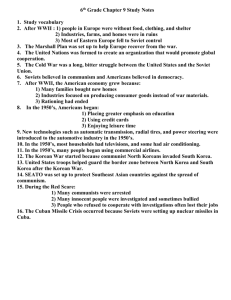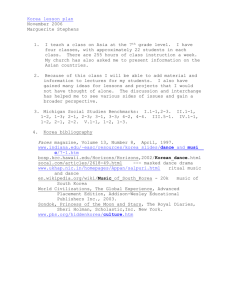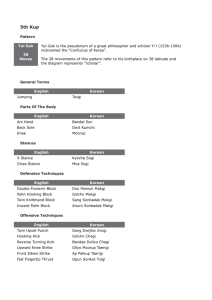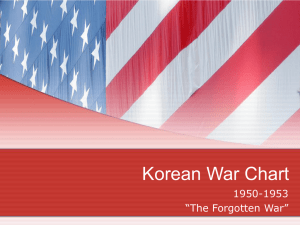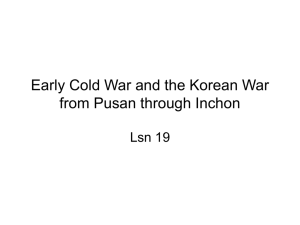Lesson 1 - Key Social Developments of the 1950s
advertisement
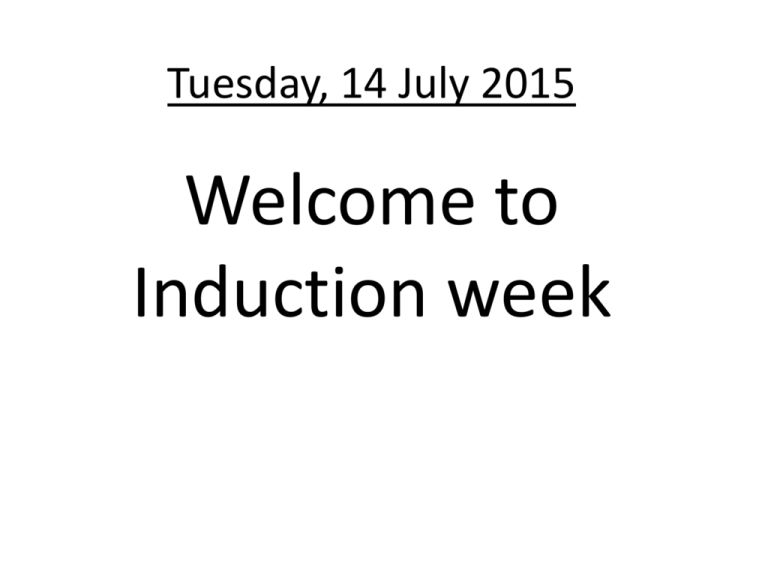
Tuesday, 14 July 2015 Welcome to Induction week What was America like in the 1950s? Decade of contrast •Fear of Nuclear War •Segregation/KKK •Race riots •Limited enforcement of Civil Rights Legislation •Korean War •McCarthyism •Post war affluence •New products •Marilyn Monroe/James Dean •Some Legal success for Civil Rights Campaigners Source sheet 1 – The Cold War Many Americans, fearful of nuclear war, still looked for ways to prepare for survival. Civil defence pamphlets gave instructions on stocking basements with water, canned goods, and flashlights. In the suburbs, some families built backyard bomb shelters — underground bunkers in which they could take shelter from a blast and wait out the worst effects of radiation. In October 1957, the world was introduced to the fear of a missile attack when Sputnik was launched. This was to lead to ICBM’s : Inter-continental ballistic missiles. As a result, America built the DEW line around the Artic – Defence and Early Warning system. At the end of the 1950’s, American Intelligence estimated that in a Russian missile attack, 20 million Americans would die and 22 million would be injured. Source sheet 2 - McCarthyism HUAC’s targets included left-wingers in Hollywood and liberals in the State Department. In 1950, Congress passed the McCarran Internal Security Act, which required that all “subversives” in the United States submit to government supervision. (President Truman vetoed the Act—he said it “would make a mockery of our Bill of Rights”—but a Congressional majority overrode his veto.) “McCarthyism,” as the hunt for communists in the United States came to be known during the 1950s, did untold damage to many people’s lives and careers, had a muzzling effect on domestic debate on Cold War issues, and managed to scare millions of Americans. McCarthy, however, located no communists and his personal power collapsed in 1954 when he accused the Army of coddling known communists. Televised hearings of his investigation into the U.S. Army let the American people see his bullying tactics and lack of credibility in full view for the first time, and he quickly lost support. The U.S. Senate censured him shortly thereafter and he died in 1957. "Are you now, or have you ever been, a member of the Communist party?" In the 1950s, thousands of Americans who toiled in the government, served in the army, worked in the movie industry, or came from various walks of life had to answer that question before a congressional panel. Source sheet 3 – The Korean War On June 25, 1950, the Korean War began when some 75,000 soldiers from the North Korean People’s Army poured across the 38th parallel, the boundary between the Soviet-backed Democratic People’s Republic of Korea to the north and the pro-Western Republic of Korea to the south. This invasion was the first military action of the Cold War. By July, American troops had entered the war on South Korea’s behalf. As far as American officials were concerned, it was a war against the forces of international communism itself. Finally, in July 1953, the Korean War came to an end. In all, some 5 million soldiers and civilians lost their lives during the war. The Korean peninsula is still divided today. The Korean War was a war between North and South Korea, in which a United Nations force led by the United States of America fought for the South, and China fought for the North, which was also assisted by the Soviet Union Source sheet 4 – Civil Rights The governor of Arkansas, Orval Faubus, obstructs the integration of Little Rock High School, using the National Guard to block the entry of nine students. President Eisenhower orders federal troops to integrate the school. 1956 Violence erupted in scattered regions throughout the South as black children began to enrol in public schools. In April, singer Nat “King” Cole was attacked while performing before a white audience in Birmingham, Alabama. On August 28 1955, Emmett Till, a 14-year-old African-American boy from Chicago, is killed near Money, Mississippi, for allegedly whistling at a white woman. In January and February 1956, whites angry about the Montgomery Bus Boycott bomb four African-American churches and the homes of civil rights leaders Martin Luther King and E.D. Nixon. Use the source sheets to add to your planning grid. Which was the biggest problem affecting US society in the 1950s? Explain your answer carefully within a paragraph. 1950s novels and films • • • • • • • The Catcher in the Rye – J.D. Salinger (1951) On the Road – Jack Kerouac (1957) Naked Lunch – William S. Burroughs (1959) On the Waterfront (1954) Starring Marlon Brando Rebel without a cause (1955) starring James Dean The day the earth stood still (original 1951) Invasion of the Body Snatchers (1956)

